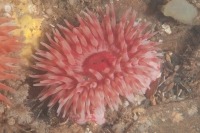
(Photo: Claire Goodwin)
Northern Red Anemone
Urticina sp.
This large anemone can be up to 20 centimetres in diameter. The colour and pattern is very variable. They are usually shades of red, white, purple, and orange but sometimes blue, grey, or green. May be plain or have stripes or blotches in a mixture of colours.
Authority
Ehrenberg, 1834
Classification Details
Phylum: Cnidaria (Cnidarians); Class: Anthozoa (sea anemones, corals, and sea fans); Order: Actiniaria (sea anemones).
Habitat
Found attached to rocks and shells from the lower shore to depths of over 80 m. There have been recent changes in the taxonomy of several Urticina species and their distributions are being refined. Many are widespread in the North Atlantic and Arctic. They can be locally common with several per metre of seabed.
Diet
Catch food using their tentacles, which are heavily armoured with stinging cells (nematocysts). They digest food in the gastrovascular cavity and eject any remains ejected from their mouth. Prey on crabs, shrimps, molluscs, urchins, and small fish.
Reproduction
Individuals are male or female. In some Urticina species males release sperm into the seawater and females take this in to fertilize their eggs. Each female broods her embryos until they develop into lecithotrophic (yolk-feeding) larvae. She releases these into the seawater where they spend up to a month floating before settling on the seabed. In other Urticina species the female expels mucus containing eggs from its mouth and the male expels sperm in the same fashion. Eggs are fertilized externally. They develop into a swimming planula larva which eventually settles to the seabed. Adults can live for over 50 years.
Fun Facts
We are not certain which species the large red anemones found in this area belong to. Scientists previously thought that they were Urticina felina but this species is probably restricted to Europe. From preliminary microscopic examination of the cnidae it seems they are probably Urticina eques but they might be Urticina crassicornis. We will need to examine more specimens and sequence their DNA to be sure.
Around 77% of northern red anemone larvae are chimeric. This is where two embryos have fused to form one individual megalarvae. Scientists think that the super-anemones formed from these megalarvae might be better able to defend themselves or grow faster. The extra genes may help them cope with changing environments.
References
Chia FS, Spaulding JG (1972) Development and juvenile growth of the sea anemone Tealia crassicornis. Biological Bulletin, Marine Biological Laboratory, Woods Hole 142, 206–218. de Kluijver MJ, Ingalsuo SS, de Bruyne RH (2000) Macrobenthos of the North Sea http://species-identification.org/species.php?species_group=anthozoa&menuentry=soorten&id=92. Marshall M (2011) Sea anemones spawn mixed–up kids. New Scientist 2810. https://www.newscientist.com/article/dn20393-zoologger-sea–anemones-spawn-mixed-up-kids/ Accessed online 22 January 2020. Mercier A, Sun Z and Hamel J-F (2011) Internal brooding favours pre-metamorphic chimerism in a non-colonial cnidarian, the sea anemone Urticina felina. Proceedings of the Royal Society B, Biological Sciences 278, 3517–3522 https://royalsocietypublishing.org/doi/10.1098/rspb.2011.0605. Sanamyan NP, Sanamyan KE, Mercier A, Hamel J-F, Bocharova ES (2020) Morphological and molecular assessment of large sea anemones (Actiniaria: Actiniidae) in Newfoundland (eastern Canada). Polar Biology https://doi.org/10.1007/s00300-020-02652-z.

